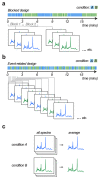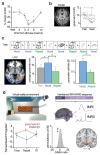Event-related functional magnetic resonance spectroscopy
- PMID: 37244321
- PMCID: PMC7614684
- DOI: 10.1016/j.neuroimage.2023.120194
Event-related functional magnetic resonance spectroscopy
Abstract
Proton-Magnetic Resonance Spectroscopy (MRS) is a non-invasive brain imaging technique used to measure the concentration of different neurochemicals. "Single-voxel" MRS data is typically acquired across several minutes, before individual transients are averaged through time to give a measurement of neurochemical concentrations. However, this approach is not sensitive to more rapid temporal dynamics of neurochemicals, including those that reflect functional changes in neural computation relevant to perception, cognition, motor control and ultimately behaviour. In this review we discuss recent advances in functional MRS (fMRS) that now allow us to obtain event-related measures of neurochemicals. Event-related fMRS involves presenting different experimental conditions as a series of trials that are intermixed. Critically, this approach allows spectra to be acquired at a time resolution in the order of seconds. Here we provide a comprehensive user guide for event-related task designs, choice of MRS sequence, analysis pipelines, and appropriate interpretation of event-related fMRS data. We raise various technical considerations by examining protocols used to quantify dynamic changes in GABA, the primary inhibitory neurotransmitter in the brain. Overall, we propose that although more data is needed, event-related fMRS can be used to measure dynamic changes in neurochemicals at a temporal resolution relevant to computations that support human cognition and behaviour.
Copyright © 2023 The Author(s). Published by Elsevier Inc. All rights reserved.
Conflict of interest statement
Declaration of Competing Interest The authors declare no competing interests.
Figures



References
-
- Baslow MH, Cain CK, Sears R, Wilson DA, Bachman A, Gerum S, Guilfoyle DN. Stimulation-induced transient changes in neuronal activity, blood flow, and N-acetylaspartate content in rat prefrontal cortex: A chemogenetic fMRS-BOLD study. NMR in Biomedicine. 2016;29(12):1678–1687. doi: 10.1002/nbm.3629. - DOI - PMC - PubMed
Publication types
MeSH terms
Substances
Grants and funding
LinkOut - more resources
Full Text Sources

